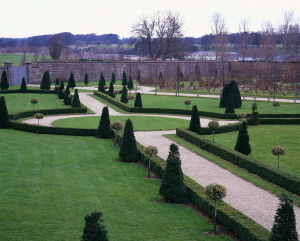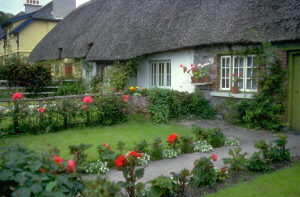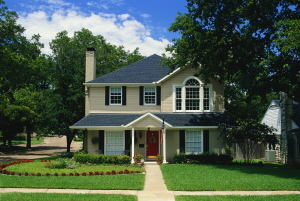|
Tips and Techniques for Landscape Gardening and What you should Know
From this study we will be able to work out a little theory of how this should be done.
In landscape gardening do not centre the tree or trees. Let them drop into the background. Make a pleasing side feature with them. In choosing trees you must keep in mind a number of things. You should not choose an overpowering tree; the tree should be a good shape, with something interesting about its bark, leaves, flowers or fruit. While the poplar is a rapid grower, it sheds its leaves early and is left standing, bare and ugly, before the fall. I would never advise planting a group of evergreens close to a house, and in the front garden. The effect is very gloomy. Houses surrounded are over capped and are not only gloomy to live in, but truly unhealthy. The requisite inside a house is sunlight and plenty of it. As trees are chosen because of certain good points, shrubs should be also. In a clump I would plant some that bloom early, some that bloom late, some for the beauty of their autumn foliage, some for the colour of their bark and others for the fruit. Some Spireas and the Forsythia bloom early. The red bark of the dogwood makes for a bit of colour all winter, and the red berries of the barberry cling to the shrub well into the winter. Certain shrubs are good to use for hedge purposes. A hedge is prettier usually than a fence. The Californian privet is excellent for this purpose. Osage orange, Japan barberry, buckthorn, Japan quince, and Van Houtte's Spirea are other shrubs that make great hedges. I forgot to say that in tree and shrub selection it is usually better to choose those of the locality where you live. Unusual and foreign plants often don’t do well. Landscape gardening may follow along very formal lines or along informal lines. The first would have straight paths, straight rows in stiff beds, everything, as the name tells, perfectly formal. The other method is, of course, the exact opposite. There are danger points in each. The formal arrangement is likely to look too stiff; the informal, too fussy, too wiggly. As far as paths go, keep this in mind, that a path should always lead somewhere. Its job is to direct one to a definite place. Now, straight, even paths are not unpleasing if the effect is to be a formal garden. The danger in the curved path is an abrupt curve, a whirligig effect. It is far better for you to stick to straight paths unless you can make a really beautiful curve.

With landscape gardening a building often needs the help of vines or flowers or both to tie it to the garden in such a way that it forms a pleasant whole. Vines lend themselves well to this work. It is better to plant a perennial vine, and let it form a permanent part of your landscape scheme. The Virginia creeper, Wistaria, Honeysuckle, a climbing rose, the clematis and trumpet vine are all satisfactory. Close your eyes and picture a house of natural colour, that mellow gray of the weathered shingles. Now add to this old house a purple Wistaria. Can you see the beauty of it? Of course, the morning-glory is an annual vine, as is the moon-vine and wild cucumber. Now, these have their special function. For often, it is necessary to cover an ugly thing for just a time, until better things and better times come. The annual is 'the thing' for this work. Flowers go well along the side of the building, or bordering a walk. In general, though, keep the front lawn space open and unbroken by beds. What lovelier in early spring than a bed of daffodils close to the house? Hyacinths and tulips, too, form a blaze of glory. These are little or no bother, and start the spring right. Some make bulbs an exception to the rule of unbroken front lawn. 
With landscape gardening you should have in mind some notion of the blending of colour. Nature does not consider this at all, and still gets wondrous effects. This is because of the tremendous amount of her perfect background of green, and the limitlessness of her space, while we are confined at the best to relatively small areas. We should not blind people's eyes with clashes of colours which do not at close range blend well. In order to break up extremes of colours you can always use masses of white flowers, or something like mignonette, which is in effect green. Finally, let’s sum up our landscape gardening lesson. The grounds are a setting for the house or buildings. Open, free lawn spaces, a tree or a proper group well placed flowers which do not clutter up the front garden, groups of shrubbery these are points to be remembered. The paths should lead somewhere, and be either straight or well curved. If you start with a formal garden, you should not mix the informal with it before the work is done.
Return from Landscape gardening to Gardening
|





 Landscape gardening has often been associated with the painting of a picture. Your art-work teacher has told you that a good picture should have a focal point or point of interest, and the rest of the points simply go to make the piece more beautiful. So in landscape gardening there must be a picture in the gardener's mind of what he desires the whole to be.
Landscape gardening has often been associated with the painting of a picture. Your art-work teacher has told you that a good picture should have a focal point or point of interest, and the rest of the points simply go to make the piece more beautiful. So in landscape gardening there must be a picture in the gardener's mind of what he desires the whole to be.







